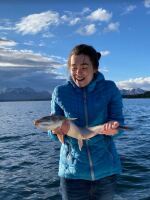At this week’s Board of Fisheries meeting, the Area M fishery is at the center of a debate on how to protect the record-low Yukon River chum salmon runs.
Much of the public testimony centered on the record-low Yukon River chum runs, and specifically on Proposal 140 to reduce the harvest by cutting down commercial fishing time in a mixed-stock fishery to the south. Area M, around the Alaska Peninsula and Aleutian Islands, is a so-called “intercept fishery” targeting salmon far from their home rivers.
The proposal was put forward by the Fairbanks Advisory Subcommittee on fisheries. It would reduce commercial fishing time in Area M’s South Unimak and Shumagin Islands fishery in an attempt to increase the number of salmon returning to Western Alaska rivers.
Some of the testimony was emotional. Michelle Quillin of Hughes, a Koyukon Athabaskan community on the Koyukuk River, said they can’t rely on the commercial industry to regulate itself. She called the decline in salmon runs on the Yukon “cultural genocide” of Alaska Native people.
“A lot of change needs to happen, but here we only ask that you pass Prop 140 and limit the time Area M has their gear in the water, because that is the only thing that will work,” she said.
Area M has become a focal point in an increasingly urgent debate around how to address declining returns there.
Proposal 140 would resurrect a management plan that was in place in the early 2000s, restricting fishing time in a June fishery that has caught an average of about 500,000 chum over the past 20 years. About half of those chum could be headed to coastal Western Alaska rivers, according to data from the state’s decade-old flagship study on salmon stocks there. The fishery also makes up a significant chunk of Area M fishermen’s income.
The proposal cited harvest numbers from the Alaska Department of Fish and Game that show that in 2021, fishermen in that area caught more than 1 million chum, while just 254,000 Yukon summer and fall chum were counted swimming to spawning grounds.
University of Washington fisheries ecologist Daniel Schindler said the proposal is reasonable because it provides windows of time for fish to swim through without being caught. He pointed out that the preliminary results of the state's 2022 genetic study shows Area M’s South Peninsula harvested about 5% of the chum swimming to Western Alaska rivers. While that sounds small, he said, it could make a big difference for weak runs.
“It sounds like hyperbole, but when the stocks are on the ropes, every fish does count a heck of a lot more than it does when the populations are at high abundance,” he said during the Committee of the Whole on Friday. “In the case of the AYK (Artic-Yukon-Kuskokwim) chum stocks right now, it’s very obvious to everyone in this room that those stocks are at very depressed abundances.”
Meanwhile, people along the Yukon River and its tributaries haven’t been able to subsistence fish for chum for years, and they say any additional conservation efforts will help. Many who support the proposal talked about those record-low returns, saying they haven’t been able to get enough fish to feed their communities or pass down traditions.
Some also pointed to the state’s subsistence priority, and said that the proposal will help share the burden of conservation.
“What can I say that you already haven’t heard? Probably not much,” said Theresa Clark, a Louden tribal member who lives in Galena and works for the Yukon River Intertribal Watershed Council, which includes 57 tribes.
“Like the commercial fishers that fish southwest Alaska and the Aleutians, we also want to maintain our lifestyle and pass on the ways of our life and livelihood to our youth,” said Clark; their subsistence needs are not being met, and smokehouses have been empty for years. “We cannot teach our youth to preserve salmon anymore as we cannot fish for salmon. Our fish camps are not being used as we have not fished.”
Climate change is also a focus at the meeting. Fish and Game salmon ocean ecology program leader Katie Howard presented data on how recent chum crashes correlate with warming waters in the Bering Sea and North Pacific between 2016 and 2019. Howard said the fish were not getting enough nutrients because their primary food sources had declined.
“They were experiencing extraordinary heat waves during their first summer at sea, so in these regions,” Howard said. “Those that survived until winter were then hit with a heat wave in the North Pacific Ocean, so they just couldn’t escape it during their first year at sea.”
Some Area M fishermen, like Jared Danielson, say reducing fishing time won’t significantly help chum runs. Danielson said the proposal would harm them more than it would help the chum.
“The low harvest rates in Area M are of low significance to the AYK chum salmon swimming through the Gulf of Alaska,” he said. “The evidence by Fish and Game earlier in this meeting points to our ocean being on empty, not Area M.”
Nadine Kochuten is from False Pass and King Cove and now lives in Anchorage. She said restrictions on Area M fishing would harm communities on the south shore of the Alaska Peninsula.
“The constant attack on our fishery and our right to continue fishing in Area M threatens our way of life, which is ultimately a subsistence way of life,” she said. “We shouldn’t have to constantly defend our right to participate in our Area M commercial fishery. Salmon are a shared resource in Alaska.”
The Board of Fish meeting was originally set to end today but will likely run two days longer than scheduled. The board will have to decide on this and other proposals before the end of the meeting.
The board is deliberating on proposals today. The meeting is being streamed live on YouTube.
Get in touch with the author at izzy@kdlg.org or 907-842-2200.



